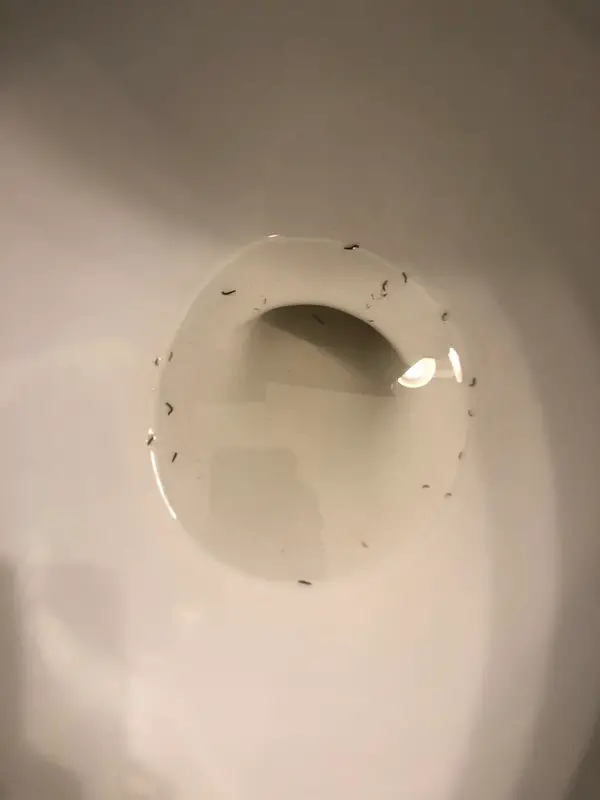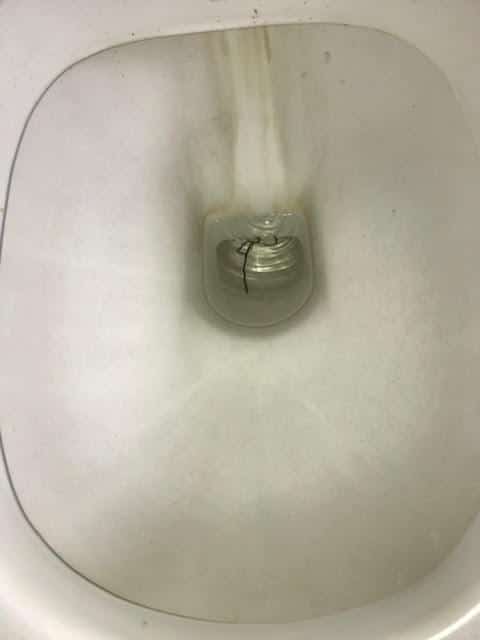Did you see small worms in the toilet after you came home from vacation?
Worms in the toilet may sound like a strange and unappealing topic. Still, it is a common problem many homeowners may encounter, especially in areas with heavy rainfall and high humidity.
Even if you flush it, they may show up in the toilet bowl overnight.
These worms feed on organic material that can build up in drains and sewage systems, such as food particles, stuck drain hair, and soap scum. We will go across types of worms in toilets and ways to prevent and remove them.
Types of Worms in Toilet

There are several sorts of worms that can live in your toilet. They can be in various colors, sizes, and circumferences.
There are many species of worms in toilets, so it isn’t uncommon to spot them. Not all of them pose health hazards, and the reason why they appeared might be different.
The four most common worm species that you might find are:
- Earthworms
- Bloodworms
- Horsehair worms
- Dry fly larvae
Earthworms
Earthworms are worms that live in soil and feed on organic matter. They are tubular-looking and live in many different areas of the world. They are harmless, and they can’t hurt humans in any way. They carry organic matter deep inside the ground, enriching the soil’s quality. [1]
Also, their excreta is rich in plant nutrients. Without earthworms, organic farming would be much more difficult. It is rare for earthworms to appear in your bathroom, but this might happen. The appearance of these worms in toilet typically means you have a cracked sewer pipe.
The cracks on the pipe serve as an entrance that earthworms go through. The appearance of earthworms doesn’t have to indicate that the bathroom is dirty, even though they look gross.
Bloodworms
Bloodworms are another pest commonly found in the bathroom. They are easily distinguishable by their bright red color that they are named after.
Bloodworms aren’t really worms, but rather the larvae of the midge fly. Due to the high amount of iron-porphyrin protein they have in their blood, they don’t need a lot of oxygen.
This is why they thrive in dirty, polluted water, which has low oxygen levels.
Some species of bloodworms can bite, and their bite is mildly venomous. Their bite can hurt, but it won’t cause serious harm to humans. [2]
If you notice bloodworms in your bathroom, there is probably something wrong with your water. They might be a sign of a serious lack of hygiene, as well.
Horsehair Worms
Horsehair worms are far from cute, despite what their name might be suggesting. They are parasite worms that live inside insects such as cockroaches, grasshoppers, beetles, and crickets.
Don’t let this worry you, as they aren’t parasites to humans, pets, or livestock. Horsehair worms are long but very thin, making them easily distinguishable.
When they mature, horsehair worms mate in water, which is how they might enter your toilet.
Horsehair worms typically reach our toilets while they are still eggs. This is why it may seem like they have appeared out of nowhere. [3]
They are relatively rare, and you can usually notice them while knotted up as a hairball.
Drain Fly Larvae
Drain flies are a common bathroom pest, but most people don’t know how to recognize their larvae. Drain fly larvae look like tiny, slender worms, with a dark stripe on their dorsal area.
They have a dark breathing tube that is easily noticeable. Drain fly larvae aren’t dangerous to humans.
If you have drain fly larvae, this is a sign you also have a drain fly infestation. This isn’t a sign of a lack of hygiene or a dirty bathroom. Still, having any kind of worms in toilet is never a pretty sight.
How to Get Rid of Worms in Toilet?

As we’ve already mentioned, it is very rare for an earthworm to enter your toilet. If this does happen, you want to get rid of them as soon as possible. At the same time, it’s essential to try to find the root of the problem.
There are a few remedies for earthworms that you probably already have in your house. These include:
- Pesticide treatment concentrate
- Toilet lotion
- Curry salt
- Powdered salt
Any of these substances will kill earthworms almost instantly. However, if you want to keep them from reappearing, you should look at your pipes.
Earthworms are usually an indication that there is something wrong with your sewers. If you suspect you have a leak somewhere, it would be best to contact a local plumber. Earthworms come from the earth, and their appearance probably means there’s a crack.
Another common way earthworms might enter your house are cracks in the tiles. If you live on the ground level, this is probably how they got inside.
Check out your floor tiles and make sure there aren’t any cracks. Luckily, you can do this by yourself, and there is no need to pay for a professional. All you need is some tile glue or cement, and you’re good to go.
How to Get Rid of Bloodworms in Your Toilet?

Bloodworms prefer living in stagnant water, and they can be found in bathtubs, sink, and toilet. In fact, if you have a bathroom you don’t use regularly, this is a perfect habitat for bloodworms.
As they feed on organic matter, toilets present an excellent living place for them.
Luckily, you can get rid of bloodworms very quickly. The only thing you need to do is to clean your toilet thoroughly! Make sure everything is disinfected and clean.
An excellent way to do this without using chemicals is to use vinegar and baking soda solution. For this task, you’ll need:
- Apple cider vinegar
- Baking soda
- Spraying bottle
Mix vinegar and baking soda until you have enough solution to fill a spraying bottle. Typically, you should use a 1/3 cup of soda per cup of vinegar.
Then, spray this on drains and similar surfaces that have bloodworms. It isn’t such a bad idea to pour this solution down your toilet and drain, then use boiling water.
This way, you’ll get rid of any organic matter that bloodworms eat. Making sure your toilet is clean is the best way to prevent bloodworms from coming back.
They can’t survive in clean, running water, which is why keeping your bathroom clean is the best prevention.
How to Get Rid of Horsehair Worms?

Horsehairs are long, thin, slender worms harmless to humans at any stage of their life. [4]
The presence of horsehair worms in toilet usually means that their eggs have found a place inside your home. This might also indicate that their host, such as a grasshopper, died nearby.
If you suspect their eggs have contaminated your bathroom, make sure you clean everything up. Spray the vinegar and baking soda mixture on any moist surface. This will kill the eggs, preventing new worms from appearing.
How to Get Rid of Drain Fly Larvae?

Drain flies breed in wet places such as drains, sewers, and septic tanks. As they are commonly found underground, you’re unlikely to notice one.
However, this might happen. Also, if you see drain flies, chances are you have a problem with their larvae, as well.
To inspect the area and get rid of drain flies and their larvae, you’ll need:
- A sticky tape
- Salt
- Vinegar
- Baking Soda
- A water pot
The first step should be finding out where drain flies come from. The quickest way to do so is to use sticky tape.
Place it on top of the drain, making sure the sticky side is down. Leave it overnight. Flies will eventually try to get away from the gutter, but they’ll end up stuck on the tape.
If you notice drain flies on the tape, you can be sure you have their larvae inside the drain, as well.
The next step is getting rid of drain fly larvae residing in your drain. You can do so with some heavy-duty cleaning supplies, but there’s no need to be that drastic.
The best idea would be to try using natural solutions first.
Create a mixture using a cup of vinegar, ½ cup of salt, and ½ cup of baking soda. Pour everything down the drain, and leave it overnight.
This mixture is toxic for drain fly larvae, which will die soon after. To make sure everything is sterilized, pour boiling water the next morning.
If any larvae survived the mixture, boiling water would get rid of them. Wait for a week, then repeat everything if you still notice drain fly larvae in your toilet. [5]
How to Prevent Any Future Infestations

Usually, there isn’t any guarantee that worms or any other pests won’t reappear. However, some preventative measures can be made. Even though the exact prevention depends on the species involved, there are a few universal steps.
Worms typically appear if you have stagnant water that isn’t going anywhere. This is usually the same environment that is suitable for mold and mildew.
If you’re making sure you’re regularly using all water supplies, you’ll prevent the pilling up of any organic matter.
Flush the toilets you don’t use at least once every few days. Also, don’t leave your bathroom to stay wet for too long.
Adequate ventilation is another thing that you should pay close attention to. If there is enough fresh air, you won’t have too many problems with mildew and moisture.
Make sure your bathroom is clean at all times. Spray everything with vinegar and baking soda at least once a month – preferably once a week.
Cleaning your tiles with a steamer. This way, you’ll kill any eggs before worms in toilet appear.
As we’ve mentioned before, most worms enter your bathroom from outside. A good preventative measure is to cover any potential entries. Ensure your window and door frames are appropriately sealed and that nothing can go between them and the walls.
Vents and air conditioners should be cleaned at least every few months. If you have any broken tiles, seal them with caulk or cement, especially if you live on the ground floor.
Insects and worms need a way to enter your house. If they can’t, you won’t have any issues. Also, make sure none of your pipes are broken or leaking. If they are, you’ll have more to worry about than just worms in a toilet.
Bad housing conditions will affect the health of inhabitants, therefore is important to keep everything tight and clean. [6]
Read Also: What To Pour Down Drain To Kill Roaches
Bottom Line
In conclusion, worms in the toilet may be an unsightly and unpleasant problem, but it is a common issue that can be easily prevented and eliminated. These worms, also known as drain flies or sewer flies, are attracted to moist and warm environments where organic material can build up.
Proper cleaning and maintenance of the plumbing system, such as regularly cleaning the drains, eliminating standing water, and sealing any leaks or cracks, can prevent worms from breeding and thriving in your home.

Michael Davis is a heating & plumbing expert who currently works as independent contractor in SC. He also writes for Plumbertip.
For almost 10 years he worked on various plumbing tasks across South Carolina.



